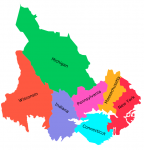So, I've been in touch with the good people at the Library of the Swedish Bureau of Patents and Registries (
Patent och Registreringsverket), and for some reason, they actually have very detailed electronic resources on the votes on county level in American presidential and gubernatorial elections in the 19th century. Why would a Swedish government agency dealing almost entirely with intellectual property law have access to such resources? Well, the librarians explained to me that the Library doesn't really buy their electronic resources on a title-by-title basis. Usually, they just buy entire packages, of which only a fraction are things that are of interest from an intellectual property angle, and then they just get an awful lot of access to additional information that is entirely useless for their purposes.
But not useless to mine!
So, what am I going to do?
Well, the problem I have with generating election results is that I want them to be, how do I put this...
plausible-looking. Now, for a given single election, it would be pretty easy to come up with a good plausible-looking result. Take for instance, shall we say... ah! The Scanian constituency of Jerrestad och Albo. Prior to the advent of 19th century and social democracy and all that jazz, the FPTP-constituency it more or less corresponds to in the old Swedish system was first a staunchly Free Trade-district, and then a fiercely Liberal Coalition Party district. Consequently, it seems plausible that in 1867, they're a fairly strong Cap district. So, let's say we have a result of...
Jerrestad och Albo
Population: 23,763 Total Votes: 5,465
Cap 4,003 73.2%
Hat 1,462 26.8%
CAP VICTORY
Maj. 2,541 46.5%
Now that looks reasonable, does it not?
But that's the problem, it looks reasonable as a single data point. I'm going to need to have around 200 data points for Sweden, and it doesn't matter if every single data point looks reasonable. If the distribution of those data points do not follow a normal distribution, everything is completely and utterly bonkers! All I've accomplished then is to lose the war despite winning every battle.
And I have reason to be concerned, for humans are
terrible random number generations.
So how am I going to accomplish this then? Why, by stealing electoral results from elsewhere!
In a way.
To give a very simplistic example (I will of course be using more data than this later!), Scania perhaps can be likened unto Cornwall. So let's take a fairly Liberal stronghold in Cornwall from the 19th century and look at the elections there where there were both Liberals and Conservatives on the ballot! Bodmin is a good example! It was so strongly Liberal, that in many elections, there were two Liberals standing for the place in a given election, and the Conservative candidate came a distant third. Of course, this changed when Gladstone began pushing for Irish Home Rule and the constituency became a marginal seat between the Liberals and the Liberal Unionists, but bear with me... We have four data points here. We calculate the average and the stand deviation when it comes to the Liberal percentage, we construct a normal distribution based on this data, take a random number according to the probabilities such a normal distribution follows...

...and presto!
Jerrestad och Albo
Population: 23,763 Total Votes: 5,465
Cap 3,610 66.1%
Hat 1,855 33.9%
CAP VICTORY
Maj. 1,755 32.1%
Now that looks reasonable, does it not?
But as I am using actual election results as the foundation here, and generating random numbers according to a normal distribution in the first place, this time, when it comes to the actual spread of the data, it is more likely to resemble a good, reasonable outcome of a general election!
This is of course not what
@Thande did for Canada/US, but it is inspired by it. Now, I just need to find election results that I can use for my data set, and that will entail finding a set of historical constituencies, probably several in different combinations, and use that information to generate a big bunch of averages and standard deviations for the various constituencies in this our fictitious Nordic Empire!
Parts will be taken from England in the 19th century, parts from America in the 19th century, and with that data at my hands, we shall indeed soon enough have our election results!







